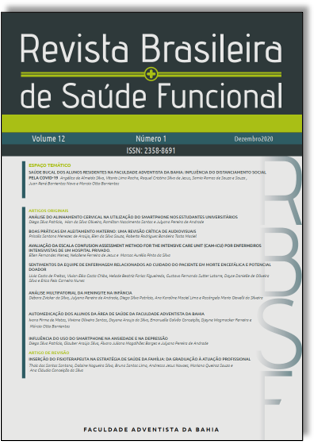ANALYSIS OF CERVICAL ALIGNMENT IN THE EXCESSIVE USE OF SMARTPHONE IN UNIVERSITARIOS
DOI:
https://doi.org/10.25194/rebrasf.v8i3.1272Abstract
Introduction: The exponential advancement of technology and mobile devices has brought with it several benefits for society, its advancement is size that occupies almost all subjective spheres known to modern humans, so there was a sudden change in how man related and related. with new technologies increasing time and intensity in its use, which has alerted researchers and health professionals worldwide about the harms of this exacerbated use, causing possible pain, postural misalignment and muscle fatigue. Thus, this study aims to collect and correlate data regarding the exacerbated use of the smartphone and its possible disorders in the cervical spine. Method: It was used the type of descriptive research with quantitative approach, conducted at the Adventist College of Bahia (FADBA). 100 students from the health courses (Nutrition, Nursing, Psychology, Physiotherapy and Dentistry) participated in the study. Initial data were obtained and classified by SAS as dependent (84%) and non-dependent (16%) and the cervical alignment and mobility variable were evaluated by the cervical goniometer instrument. Results: It was evidenced that from the sample 16 people (16%) had no dependence; while 68 (68%) mild dependence; 14 (14%) Moderate; 1 (1%) Serious. The average angulation of cervical flexion was 54.7 °, the average cervical flexion in dependent 54.6 °, and the average 55.62 ° in nondependent participants. Conclusion: With the data presented, it is possible that there is a decrease in cervical range of motion in flexion and extension of dependent individualsDownloads
Published
2020-12-21
How to Cite
Pereira de Andrade, J., Patrício, D., Oliveira, H., & Santos, R. . . (2020). ANALYSIS OF CERVICAL ALIGNMENT IN THE EXCESSIVE USE OF SMARTPHONE IN UNIVERSITARIOS. Revista Brasileira De Saúde Funcional, 8(3), 10. https://doi.org/10.25194/rebrasf.v8i3.1272
Issue
Section
Artigos


